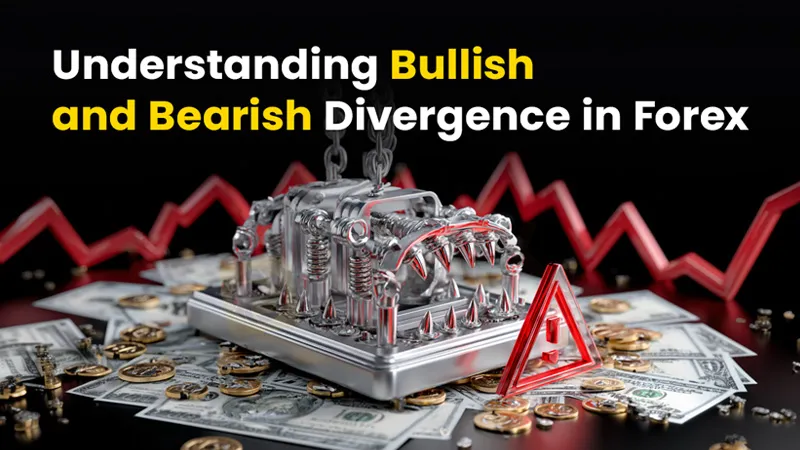Understanding Bullish and Bearish Divergence in Forex
Abstract:One of the most effective yet often overlooked tools in technical analysis is divergence, specifically bullish and bearish divergence. Understanding how to spot and interpret divergence can significantly enhance your ability to identify trend reversals and improve your entry and exit points.

One of the most effective yet often overlooked tools in technical analysis is divergence, specifically bullish and bearish divergence. Understanding how to spot and interpret divergence can significantly enhance your ability to identify trend reversals and improve your entry and exit points.
What Is Divergence in Forex?
Divergence occurs when the price of a currency pair moves in the opposite direction from a technical indicator. Divergence is a sign that the current trend may be weakening and that a potential reversal or pullback could be imminent.
Types of Divergence
There are two main types of divergence in forex:
- Bullish divergence
- Bearish divergence
Bullish Divergence
A bullish divergence forms when the price of a forex pair makes a lower low, but the indicator forms a higher low. This indicates that selling pressure is weakening, despite the price still falling. It often precedes a bullish reversal.
Bearish Divergence: Warning of Potential Downturns
A bearish divergence happens when the price makes a higher high, but the indicator shows a lower high. This suggests that buying momentum is fading, even as the price climbs, and could indicate a trend reversal to the downside.
Example:
- Price: Higher high
- MACD/RSI: Lower high
This indicates weakening bullish momentum and potential selling pressure ahead.
Ideal Trading Conditions:
- During an uptrend
- When prices are overbought
- Confirmed by resistance levels or candlestick patterns
Regular vs. Hidden Divergence
In addition to standard divergence, there's also hidden divergence, which can signal trend continuation rather than reversal.
| Type | Signal | Price Action | Indicator |
| Regular Bullish | Reversal | Lower Low | Higher Low |
| Regular Bearish | Reversal | Higher High | Lower High |
| Hidden Bullish | Continuation | Higher Low | Lower Low |
| Hidden Bearish | Continuation | Lower High | Higher High |
Tools for Identifying Divergence
Several indicators help traders identify divergence effectively, they are:
- RSI (Relative Strength Index)
- MACD (Moving Average Convergence Divergence)
- Stochastic Oscillator
- Awesome Oscillator
You can apply these strategies on popular trading platforms, such as MT4, MT5, TradingView, or cTrader. We also advise you to use candlestick patterns frequently. Do not rely on divergence alone in high-volatility markets or during news releases. In addition, traders should practice with demo accounts before using real capital.
Conclusion
Bullish and bearish divergences are powerful tools that can offer early warning signs of trend reversals in the forex market. When used correctly alongside other indicators and risk management strategies, divergence can give traders a valuable edge.
However, like all technical tools, divergence is not foolproof. Always make yourself comfortable and do more research can maintain a disciplined approach to trading.

Read more

What Is Indices in Forex? A Beginner’s Guide to Trading Forex Indices
Understand what indices in forex are, how DXY works, key differences vs pairs, pros/cons, and where to trade CFDs—beginner-friendly, expert-backed guide.

Malaysian Finfluencers Could Face RM10 Million Fine or 10 Years in Prison!
A new regulatory measure by the Securities Commission Malaysia (SC) is set to change the country’s online trading and financial influencer landscape. Starting 1 November 2025, any trader or influencer caught promoting an unlicensed broker could face a fine of up to RM10 million, a prison sentence of up to 10 years, or both.

Juno Markets: A Closer Look at Its Licenses
When selecting a broker, understanding its regulatory standing is an important part of assessing overall reliability. For traders seeking to protect their capital, ensuring that a platform operates under recognised and stringent oversight can make all the difference. Keep reading to learn more about Juno Markets and its licenses.

Complaints Against Weltrade | Traders Can’t Get Their Money Back
Opening a trading account and watching your capital grow can feel exciting and full of promise until the moment you realise you cannot get your money back. That’s when the dream turns into a nightmare. Recent complaints submitted to WikiFX reveal an unsettling pattern seen at Weltrade where deposits vanish, withdrawals stall for days or even months, and support channels lead nowhere.
WikiFX Broker
Latest News
What Is Indices in Forex? A Beginner’s Guide to Trading Forex Indices
How to Use Retracement in Trading
CySEC warns the public against 17 investment websites
Robinhood Moves Toward MENA Expansion with Dubai DFSA License Application
FBI Issues Urgent Warning on Crypto Recovery Scams
European leaders to join Zelensky at White House meeting with Trump
Germany's Industrial Core Is Collapsing Under The US Trade Deal And The Green Agenda
Understanding Forex Spread Cost and How to Minimize It
Juno Markets: A Closer Look at Its Licenses
Complaints Against Weltrade | Traders Can’t Get Their Money Back
Rate Calc

